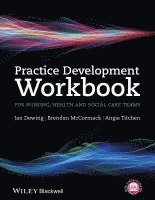
- Format
- Häftad (Paperback / softback)
- Språk
- Engelska
- Antal sidor
- 256
- Utgivningsdatum
- 2014-05-30
- Upplaga
- 1
- Förlag
- Wiley-Blackwell
- Illustrationer
- black & white illustrations, figures
- Dimensioner
- 277 x 224 x 15 mm
- Vikt
- Antal komponenter
- 1
- ISBN
- 9781118676707
- 658 g
Practice Development Workbook for Nursing, Health and Social Care Teams
Resources for Health and Social Care Teams
Kundrecensioner
Fler böcker av författarna
-
Person-Centred Practice in Nursing and Health Care
Brendan McCormack, Tanya McCance
-
Person-centred Nursing Research: Methodology, Methods and Outcomes
Jan Dewing, Brendan McCormack, Tanya McCance
-
Fundamentals of Person-Centred Healthcare Practice
Brendan McCormack, Tanya McCance, Cathy Bulley, Donna Brown, Ailsa McMillan
-
Person-Centred Healthcare Research
Brendan McCormack, Sandra Van Dulmen, Hilde Eide, Kirsti Skovdahl, Tom Eide
Övrig information
Jan Dewing is Head of Person-centred Research and Practice Development at East Sussex Healthcare NHS Trust, Eastbourne, UK; Co-Director, Centre for Practice Development (including Lead for Kent Sussex Surrey, Dementia Care Innovation Hub), Canterbury Christchurch University, Canterbury, UK; Visiting Professor, Person-centred Practice Research Centre, University of Ulster, Ulster, Northern Ireland; Visiting Professor, School of Nursing & Midwifery University of Wollongong, Wollongong NSW, Australia. Brendan McCormack is Director of the Institute of Nursing and Health Research, and Head of the Person-centred Practice Research Centre, University of Ulster, Ulster, Northern Ireland; Professor II, Buskerud University College, Drammen, Norway; Adjunct Professor of Nursing, University of Technology, Sydney, Australia; Visiting Professor, School of Medicine & Dentistry, University of Aberdeen, Aberdeen, Scotland. Angie Titchen is Independent Practice Development Consultant, Principal Investigator at the Knowledge Centre for Evidence-Based Practice, Fontys University of Applied Sciences, Eindhoven, The Netherlands; Visiting Professor, University of Ulster, Ulster, Northern Ireland; Adjunct Professor, Charles Sturt University, Bathurst NSW, Australia; Associate Fellow, University of Warwick, Warwick, UK.
Innehållsförteckning
Preface ix About the companion website xi 1 Introduction: Getting the best out of this resource 1 Introduction 1 This resource matters because 4 Who is it for? 5 How can this resource be used in your workplace? 7 What is practice development? 9 The principles of practice development work 11 The person-centred practice framework 12 Useful websites and resources 14 2 Knowing and demonstrating values and beliefs about person-centred care 17 Introduction 17 Reflection on my own values and beliefs about the care/services I give or receive 20 Going for a reflective walk on your own or with someone else 21 Values and beliefs of the care setting 23 Leaders values and beliefs 25 Sheet 2.1: Worksheet for recording learning activities with a buddy: Values and beliefs about care 27 Sheet 2.2: Discussion groups 28 Discussion trigger 2.1: Short videos 30 Quick evaluation to raise profile of values and beliefs in the care home (available on companion website) Invitation and information sheet for patients/residents, families and care staff for the values and beliefs clarification activity (available on companion website) Discussion trigger 2.2: Posters (available on companion website) Discussion trigger 2.3: Factsheets (available on companion website) Discussion trigger 2.4: Scenarios (available on companion website) Discussion trigger 2.5: Scenarios created by sensory walkabouts (available on companion website) Discussion trigger 2.6: Accessing group/team values and beliefs through emotional triggers (available on companion website) Sheet 2.3: Handout: How to feature values and beliefs in your work around the care setting/care home 32 Sheet 2.4: Values and beliefs template 33 Sheet 2.5: Values and beliefs clarification activity: A facilitators guide (This section also includes materials that are on the companion website) 34 Sheet 2.6: Instruction sheet for patients/residents, families and care staff for the values and beliefs clarification activity 38 3 Developing a shared vision for person-centred care 39 Introduction 39 Guide: Setting up a practice development coordinating group for visioning activities 43 Sheet 3.1: Templates for group meeting agendas and notes 44 Sheet 3.2: Group relaxation activity (available on companion website) 45 Sheet 3.3: Creative methods for developing a shared vision: Programme of three workshops (you decide which one you might do) 45 Sheet 3.4: Workshop guidance: Visualisation through painting and/or collage 46 Sheet 3.5: Workshop guidance: Creating and sharing personal visions 48 Sheet 3.6: Workshop guidance: Vision statement development 50 Sheet 3.7: Guide: Visioning with a virtual group 51 Sheet 3.8: Questionnaire: Developing a shared vision for person-centred care at 52 Sheet 3.9: Visioning the practice development processes and developing ground rules (one-to-one) 53 Sheet 3.10: Visioning the practice development processes and developing ground rules (small informal group) 55 Sheet 3.11: Workshop guidance: Visioning the practice development processes and developing ground rules 57 Sheet 3.12: What do we do next? 58 Useful websites and resources 59 4 Introduction to measuring progress and evaluation 60 Introduction: Why measuring and evaluation is important 60 Workshop guidance: Current evaluation methods within your organisation 63 Trigger for group discussion: What are metrics and how do we measure person-centred care? 65 Trigger for group discussion: Practice development principles for measuring and evaluation 66 Learning activity for teams: Evaluating care plans 67 Learning activity for teams: Evaluating your respect for dignity, privacy and the control people have in your service 70 Learning activity for teams: Cats, skirts, handbags and lipstick 73 At a Glance: Summary plan for personalised care (available on companion website) Learning activity for staff who serve food &
Du kanske gillar
-
Bad Therapy
Abigail Shrier
Inbunden
